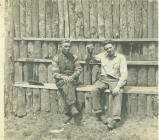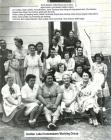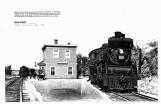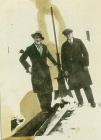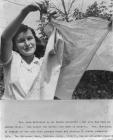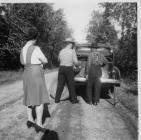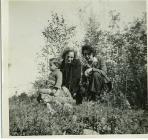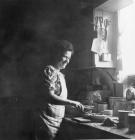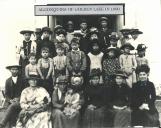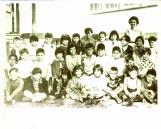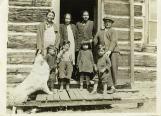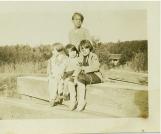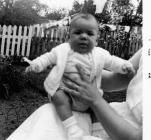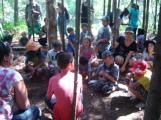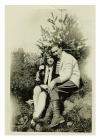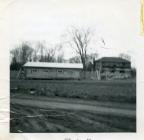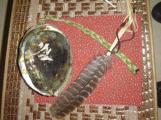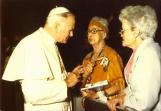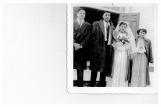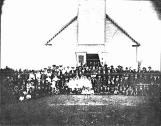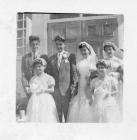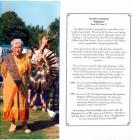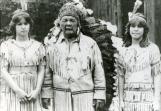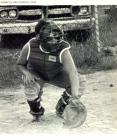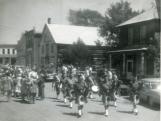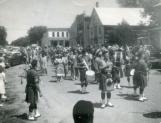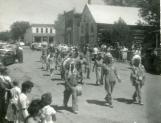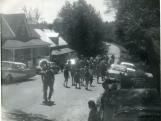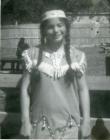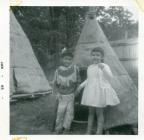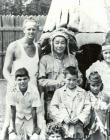

Algonquin Way Cultural Centre (The)
PikwÓkanagÓn (Golden Lake), Ontario
1
The Indian Agent: Harvey RuddyA non-Native government official, had the authority to issue, or to deny, us a permit to leave the reserve.
3
Indian Agents also decided who qualified to continue their education once Indian Day School on the reserve was completed.5
During the depression some girls went by train to the convent at St. Jacques in Quebec,7
where they were taught weaving. Then, Indian Affairs sent some looms to Golden Lake, but didnĺt send any thread. After they learned that we couldnĺt afford to get the thread ourselves, they took them back.9
The rail line had a junction on the reserve between the Ottawa line coming from Barryĺs Bayand the branch line west to Pembroke.
11
Some of us, to avoid the stigma that had become associated with being Indian, or in order to try to improve our circumstances, rode the train to cities, or north to the bush to try to find work. Some of us jumped the train, avoiding the Indian Agent pass issue, in order to spend the day at Pembroke.13
The trains allowed transport, but also placed us in jeopardy ľ wartime soldiers often came to the reserve by train looking for women to take advantage of and abuse. Many of our women were afraid to walk alone to the Village of Golden Lake, as the path ran beside the rail line.15
Those of us living on the reserve never really noticed the Great Depression, as our lives stayedthe same as before. We used kerosene or coal oil lamps unless we had the luxury of the much
brighter Aladdin lamp for light. If there wasnĺt money for coal oil in the winter, sometimes
weĺd use a candle to eat supper by, and then go to bed. Winter nights were long.
17
We heated and cooked with wood and used outhouses.19
There was no hydro on the reserve until the 1950ĺs and then, it was a challenge to get money to wire our houses to hook-up.21
Most families got water from the lake all year for our needs, except for a few families that had a dug well and a pump.There was also a pump with good water at the second school on the reserve, located
at the old log museum building, which many families used.
23
We treated ourselves for every aliment, because medical services werenĺt available.People
made teas, salves, and poultices from balsam, cedar, spruce, goldenrod, slippery elm and many
other plants. We treated everything from infections, coughs, toothaches to burns and fevers.
People knew what part of the plants to use and when to gather them, and they gathered them
in a good way. Some people still know the medicines today.
25
In the early days on the reserve, we had mid-wives to help with births, and once doctorsbecame available, our women often said that the mid-wives were better at delivering babies.
27
At Indian Day School you could go up to senior 4th or grade eight.In those times we came to school in bare feet if we didnĺt have shoes, and in the winter, once it was cold enough, we could wear moccasins because they wouldnĺt get wet. In the winter it was hard for some of us to get to school. Sometimes the snow was so high that you couldnĺt even see the boxcars when the train went through. Some children had to walk up to three or four miles.
Some of us came on sleds that our dogs pulled.
29
The third school, located where the post boxes are now, was still one room for all grades. There was a teacherĺs residence built over top.Someone would come in early and fire-up the wood stove and lunch was cooked there. We were also fed wood-like, government-issue vitamin biscuits and cod liver oil. If there was a good teacher, we would have events like skating parties; if not, things were rougher.
After Day School we could go away to boarding school, but Indian Affairs didnĺt pay for it, and many of us were to poor to go.
We could also attend high school in Eganville by train, but you didnĺt get back till 8 at night. After
school weĺd have chores like filling the water barrel and wood box.
31
Some of our children were sent away to the Catholic residential school at Spanish and weresubjected to the physical and sexual abuse and isolation that residential school is now known
for. In this school system, they cut off our hair, separated the boys from the girls, punished us
for speaking our language, and for waving at brothers or sisters from our own families. We
were dressed in the way they believed white children should dress, and the girls were trained
to be kitchen help and boys to be farm hands. We were always hungry there, and some of us
took apples from the root cellar to eat because we were never given any.
We were cut off from our families, their caring, and the experience and stories that could teach us our traditions and history. Some of us stayed a long time, came back, and are sad remembering those times.
Often our children have suffered for our experience there. We were told by the Mounties, the
Indian agent, and childrenĺs services, who came to take our children, that ôit was for their own
good.ö Many of our children died there.
33
The implementation of government regulation and policy continued to be prejudiced,inhumane, and disheartening when family relationships suffered again as we lost our children
to what has come to be known as the ô60ĺs Scoopö. Many of our children were taken by Indian
Affairs and Childrenĺs Aid, through pressure put on young mothers in childbirth, or by taking
them, often without our consent, right from our homes, while we were struggling to try to
make ends meet.
35
Seventy percent of our children who were taken during this time were placedin non-Indian families. The agencies responsible considered us to be inferior because of our
poverty, even though it was imposed upon us by unjust legislation and circumstances. As a
result, we were alienated from our children and them from us. But the removal of our children
was slowed ľ and made to involve lengthy and costly court proceedings ľ when our band
administrator, on behalf of Chief and council, wrote to the Childrenĺs Aid Society requesting
that they follow their own rules and institute the Child Welfare Act only. Over the years, some
of our children who were adopted out found out where they were from and returned, but
many have not. Some of our relatives, who are strangers to us, still enter our lives from time to
time.
37
A daycare was started in 1979 on the reserve, and today our childrenĺs school readinessprogramming is integrated with Algonquin, English and cultural teachings.
39
Older children attend schools in the surrounding communities, since Ĺintegrationĺ was instituted in the sixties.There is an Algonquin language program at both elementary schools in Eganville, and a Native
Studies program at the district high school.
We also have a post-secondary education counsellor who helps our college and university students adjust to life on campus and achieve their goals.
43
In 1966 Indian Affairs hired a band administrator, or manager, and got rid of Indian agents; thiswas said to give us more autonomy, although all policy was still decided in Ottawa. Golden
Lake Indian Reserve #39 became part of the Peterborough District including Alderville, Curve
Lake and Scugog reserves. This self-administration policy, whereby we would administer the
funding allocated by the Department of Indian Affairs, was an attempt by the government to
overcome its previous depleting assimilation and isolation policies, which had resulted in
apathy, dependence, poverty, substance abuse, and a well-deserved mistrust of politics and
government for our people. But the new policy failed to address the core issue: an
insubstantial land base to allow sustainable economic, cultural, traditional, agricultural or
resource independence, development and management.
45
The OmÓmiwininý never separated faith from life, and we understood that helping others havea good life would make us happy. We honoured our individual right and responsibility to
understand various spiritual beliefs for ourselves, and to choose the right one for ourselves. We
have always had our traditional beliefs to guide us, even though they were misunderstood,
obstructed, and outlawed by governments and religious organizations since contact times.
47
Some of our families have been devout Christians for generations, ever since our relativesstayed at the Christian mission at Lake of Two Mountains.
49
In the early reserve days, an Algonquin-speaking mission priest would arrive once a year to perform the sacraments, and all the baptisms and marriages.51
The first Catholic Church on the reserve, which had two rows of pews and a central box-stove for heat, was built by parishioners;53
it was replaced by the current in 1954. Now, a priest comes from Eganville to say mass each Sunday.55
Some of us are strong traditionalists, some walk both Christian and Red Road together and some of us are undecided.Although some of us are willing to share our beliefs, it has never been our way to tell others
what they should believe.
57
In 1977 we built Tennisco Manor for people of various ages requiring supportive housing. Anew facility, which will also have self-contained apartments was built in 2009.
59
In 1984 we built a ball field.61
In 1989, the Makwa Community Centre for classes, events, recreational activities and presentations, was completed. It is currently undergoing refurbishing.62
Also in 1989, PikwÓkanagÓn hired a Community Health Representative; programs for medical transportation, drug and alcohol and community health were instituted. A health manager was hired and the current health centre was built and opened in 1998.63
In 2003, our current administration building replaced the old cement block one. It houses Chief and council and several departments: education, economic initiatives, social services, lands, estates and membership, and public works.69
2012 marks our 25th annual Traditional Pow Wow at Golden Lake. At this ceremonial gatheringour traditions and culture are shared through drumming, song, dance, food, celebration and
socializing, allowing us to honour our ways and the broader community an invitation to
celebrate them with us.
71
We established OmÓmiwininý PimÓdjwowin, currently housed in the old log building, in 2002 in consultation with First Nations membership and Chief and council of PikwÓkanagÓn to serve the need of protecting and restoring our cultural traditions and working with our museum collection.We are currently fundraising to build a new Cultural centre with more space to practice traditions, spirituality and language.
73
A process of enrolment began in 1992 to identify people of Algonquin descent for the purposeof electing representatives from our respective Algonquin communities. There are currently
Algonquin Nation Representatives from Antoine, Ardoch (Snimikobi), Bancroft, Bonnechere,
Greater Golden Lake, Mattawa/North Bay, Ottawa, Pikwakanagan, and Sharbot Lake (Shabot
Obaadjiwan).
75
Pikwakanagan Volunteer Fire Department1980
Pikwakanagan, ON
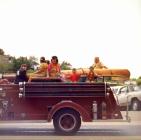 Credits:
Credits:Pikwakanagan Volunteer Fire Department
76
The earth still speaks, but not many people can hear. Our story of OmÓmiwininý of theKitchissippi Valley is now being told as we live it. Although the French, British, settlers, disease,
government restriction and assimilation legislation, dishonesty, trade politics, substances, and
religious organizations have interfered with our way of life and caused us much harm, we are
still here. We are a resilient people who have had to work hard to survive. Here, we remain
with knowledge from our ancestors that some of us have found again, about the way to live in
this place that we have always held sacred as our home. With having to overcome so many
obstacles, to survive with good balance takes time.

